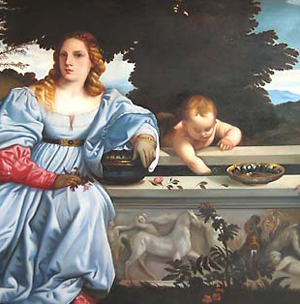
Clovis I (reigned A.D. 481–511) is considered the first king of France, though his influence was strongest in the north of the country. He converted to Catholicism, united territories, and selected Paris as the capital. Charlemagne came along a couple hundred years later, reigning (A.D. 768–
814) over an area that extended from the Baltic to the Mediterranean seas and included parts of France, Germany, and Italy. Now here was a king the people could rally behind, a great general and bold ruler. The pope in Rome crowned Charlemagne Holy Roman Emperor in 800, giving a spiritual legitimacy to his rule. These times were good for scholarship and the arts. France and Germany didn’t become separated until 843, when Charlemagne’s grandsons — Louis, Lothair, Pepin, and Charles — split the kingdom. Charles the Bald got France. He and Louis united against Lothair by taking the Oath of Strasbourg, the first known document written in French and German instead of the usual Latin. Charles, who ruled over a region whose borders resembled the France of today, developed a complex feudal system.
In 1066, William, duc de Normandie, known in history as William the Conqueror, began a campaign to conquer England, and the Bayeux Tapestry in Normandy tells the dramatic tale. In 1152, Eleanor of Aquitaine stirred things up again between France and England when she divorced the king of France (Louis VII) and married the king of England (Henry II), placing western France under English rule. War between the two countries continued on and off for hundreds of years. During the Middle Ages, the Catholic church was a powerful force in France. Holy men preached the Crusades in the 12th and 13th centuries, inciting armies of men to journey to foreign lands in the name of the church. These so-called holy armies set off to conquer lands for the Holy Roman Emperor.
Throughout the next 700 years, five dynasties held the French crown and built the monarchy into one of Europe’s most powerful. Of these kings, several stand out for their achievements in bringing about the France of today. An especially long and fruitful reign was that of Louis IX (1226–70), called St-Louis. During his reign, Ste-Chapelle and Cathédrale Notre-Dame were built on the Ile de la Cité in Paris. The arts of tapestry weaving and stone cutting flourished.
Philippe IV (the Fair), who reigned from 1285 to 1314, was instrumental in France gaining its independence from the pope in Rome. Philippe had a French pope elected, Clement V, who transferred the papacy to Avignon, where it remained from 1309 to 1378. For a brief period, two popes — one in Rome and one in Avignon — jockeyed for power. Rome eventually won out. In 1348, the bubonic plague, called the Black Death, wiped out a third of Europe’s population. Meanwhile, the Hundred Years’ War between France and England waged from 1337 to 1453. ruling consulate, but, by 1802, he was made First Consul for life. In 1804, Napoléon crowned himself emperor and his wife, Joséphine, empress as the pope looked on. The following year, he was crowned king of Italy. By 1808, having occupied Vienna and Berlin and having invaded Portugal and Spain, Napoléon seemed on his way to conquering Europe and brought great pride to the French. But after his disastrous retreat from Moscow in 1814, he abdicated and was exiled to Elba. Napoléon returned to power the following year and was defeated at Waterloo on June 18, 1815. After that defeat, Napoléon was deported to the island of St. Helena in the South Atlantic and died there in 1821. The monarchy was restored with Louis XVIII (1814–24) and then Charles X (1824–30). In 1830, Louis-Philippe I, descended from a branch of the Bourbons that had ruled France on and off since the 16th century, was called king of the French, not king of France, under a more liberal constitution, but he was forced out of office in 1847. During these politically tumultuous but fairly prosperous years, Victor Hugo, Stendhal, and Honoré de Balzac wrote great novels. In 1848, Napoléon’s nephew, Louis-Napoléon Bonaparte, was elected president of the Second Republic. In 1852, he assumed the title of emperor as Napoléon III and, with the help of Baron Haussmann, designed Paris’s grand boulevards. In July 1870, a dispute over a telegram escalated into France declaring an ultimately unsuccessful war on Prussia. As a result of the military defeats and invasion of France by Prussia, Napoléon III was removed from office. The period of 1875 to 1940 is known as the Third Republic. Meanwhile, on the cultural scene, the artists known as the Impressionists scandalized the French Academy and forever changed art. And, in 1889, at Paris’s Universal Exposition, the Tour Eiffel was unveiled. Many Parisians hated it at first, but now it’s the universally beloved symbol of Paris.



 The classical Roman period, in time, gave way to the coming of an architectural form called Romanesque (it wasn’t known as that back then). This roughly covers the period from 800 to 1100, its rise coming about because of the growing religious power of the church at this time.
The classical Roman period, in time, gave way to the coming of an architectural form called Romanesque (it wasn’t known as that back then). This roughly covers the period from 800 to 1100, its rise coming about because of the growing religious power of the church at this time. Clovis I (reigned A.D. 481–511) is considered the first king of France, though his influence was strongest in the north of the country. He converted to Catholicism, united territories, and selected Paris as the capital. Charlemagne came along a couple hundred years later, reigning (A.D. 768–
Clovis I (reigned A.D. 481–511) is considered the first king of France, though his influence was strongest in the north of the country. He converted to Catholicism, united territories, and selected Paris as the capital. Charlemagne came along a couple hundred years later, reigning (A.D. 768–